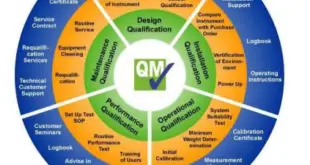Quality inspection (Self-inspections & Benefits of Self Inspection) Principle Importance and Benefits of Self Inspection What is needed Scope How can self-inspection be conducted Inspection Techniques Example of Self-Inspection Plan Who should be involved Self-inspection report Points to consider when performing self-inspection Stages of Self-Inspection Advantages & Disadvantages of Checklist …
Read More »PROCEDURE FOR QUALIFICATION/ REQUALIFICATION OF SYSTEM/ EQUIPMENT/ UTILITY/ INSTRUMENTS
PROCEDURE FOR QUALIFICATION/ REQUALIFICATION OF SYSTEM/ EQUIPMENT/ UTILITY/ INSTRUMENTS PURPOSE :To describe the procedure for equipment / facility qualification: prepare qualification protocols, to initiate, conduct, and document equipment / facility qualification studies. SCOPE : This SOP shall be applicable to all new and upgraded process related equipment /facility. REFERENCE(S) :ISPE, Volume …
Read More »Autonomous Disinfection Solution
Autonomous Disinfection Solution there is a new technological solution that has emerged in recent years to help combat the spread of disease in public spaces: autonomous disinfection robots. These robots are capable of cleaning and disinfecting public areas without human intervention, making them an ideal solution for high-traffic areas where …
Read More »Pseudoephedrine & Mechanism of Action
Pseudoephedrine & Mechanism of Action Pseudoephedrine temporarily relieves nasal congestion due to the common cold, hay fever, or other upper respiratory allergies, and nasal congestion associated with sinusitis. Pseudoephedrine also temporarily relieves sinus congestion and pressure. Drug Class: Nasal Decongestant MECHANISM OF ACTION Pseudoephedrine is a sympathomimetic drug belonging to the phenethylamine and amphetamine chemical classes. Its principal mechanism of …
Read More »Checklist for Do’s and Don’ts for Dissolution Analysis
Checklist for Do’s and Don’ts for Dissolution Analysis Checklist for Do’s Always check the availability of chemicals and required glassware for the analysis. Before loading dissolution check the Calibration status of the instrument. Always check the water level of the dissolution bath (without a bowl). Check the clarity of the water …
Read More »Checklist for Do’s and Don’ts for Using Glassware for Analysis
Checklist for Do’s and Don’ts for Using Glassware for Analysis Checklist for Do’s Use Class A Glassware for analysis Use transparent glassware for analysis Before using glassware for analysis check for cracks or breakage. Use exact capacity glassware by checking the marking of capacity e.g. ‘20’ flask not to be used …
Read More »Checklist for Do’s and Don’ts for Sample preparation of temperature / light-sensitive material and product
Checklist for Do’s and Don’ts for Sample preparation of temperature / light-sensitive material and product Checklist for Do’s In the case of temperature-sensitive / light-sensitive material collect samples from the respective storage area & allowed them to attain room temperature before using i.e weighing, pipetting, etc. During analysis close the sample …
Read More »DO’s & DON’Ts For Column care to avoid/Minimize incidences
DO’s & DON’Ts For Column care to avoid/Minimize incidences 1.0 New HPLC Columns(Except Silica Columns for Normal Phase) DO’s Before using the new column wash the column with water followed by an appropriate solvent mixture. For Silica Column for washing use solvent as Given in the Column Certificate. DON’Ts Don’t …
Read More »Checklist for Precautions during Sample Dilution /preparations in Wet Labs
Checklist for Precautions during Sample Dilution /preparations in Wet Labs Checklist for Do’s Use a bulb pipette for further dilution. During pipetting Wipe off the tip with clean tissue paper. Adjust the meniscus to eye level by discarding the solution to waste. Transfer the amount to the volumetric flask. Touch the …
Read More »SPECIFICATIONS: TEST PROCEDURES AND ACCEPTANCE CRITERIA
SPECIFICATIONS: TEST PROCEDURES AND ACCEPTANCE CRITERIA AS PER ICH Q6 A GUIDELINE Question – 1: The objective of the ICH Q6 A Guideline? Answer: ICH Q6 A Guideline is intended to assist in the establishment of a single set of global specifications for new drug substances and new drug products. …
Read More »Market complaints and product recall
Market complaints and product recall DEFINITION: A ‘Complaint’ simply designates, that something is wrong or not good enough. Generally in the pharmaceutical industry, complaints are regarding the quality of drug products. A complaint shows customer dissatisfaction about a product and consequently, about a company. Principle: All complaints and other information …
Read More »SOP on Document Management System in Quality Assurance Department.
Objective: To lay down a procedure for the Management of Documents in the Quality Assurance Department. Scope: Applicable for Document Management system in Quality Assurance department. Responsibility: Quality Assurance Department Accountability: Manager Q.A. is accountable for the compliance of this SOP. Procedure: Storage of Documents in Record Room. Documents shall …
Read More »Equipment Qualification
Equipment Qualification Manufacturers must establish a systematic approach to qualification and validation to guarantee the quality, safety, and effectiveness of their products throughout their lifecycle. It is crucial to employ statistical evaluation when necessary to provide scientific evidence that the processes, systems, or other relevant aspects are appropriately qualified or …
Read More »Flow Properties of Powders
Flow Properties of Powders The use of powders in the pharmaceutical industry has generated a variety of methods for characterizing powder flow. Not surprisingly, scores of references appear in the pharmaceutical literature, attempting to correlate the various measures of powder flow to manufacturing properties. The development of such a variety …
Read More »IMPURITIES IN NEW DRUG SUBSTANCES
IMPURITIES IN NEW DRUG SUBSTANCES To provide guidance for registration applications on the content and qualification of impurities in new drug substances produced by chemical syntheses and not previously registered in a region or member state Impurities in new drug substances are addressed from two perspectives: Chemistry Aspects include classification …
Read More »Failure Mode Effect Analysis (Risk Assessment) Compression Stage
Failure Mode Effect Analysis (Risk Assessment) Compression Stage For More Pharma Updates Visit -https://pharmaguidances.com
Read More »Standard/non-standard processes
Standard/non-standard processes The non-standard process is determined by a combination of the nature of the active substance, the nature of the finished product, the actual process itself, and the production experience of the manufacturer. All biological products are considered to be non-standard. The following categories are examples of products or …
Read More »Process validation scheme
Process validation scheme Traditional process validation Where validation data on production-scale batches are not provided with the application and traditional process validation is proposed, the process validation scheme described below should be submitted by the applicant. This should outline the formal process validation studies to be conducted on production-scale batches …
Read More »Process validation (Continuous process verification) for finished products
Process validation (Continuous process verification) for finished products Process validation can be defined as documented evidence that the process, operated within established parameters can perform effectively and reproducibly to produce a medicinal product meeting its predetermined specifications and quality attributes (ICH Q7). Continuous process verification has been introduced to cover …
Read More »Qualified Person
Qualified Persons A qualified person shall be in possession of a diploma, certificate, or other evidence of formal qualifications awarded on completion of a university course of study, or a course recognized as equivalent by the Member State concerned, extending over a period of at least four years of theoretical …
Read More »

